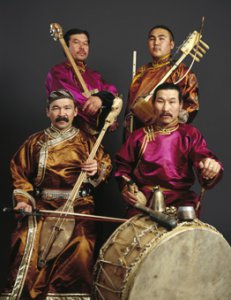 Today's issue of "Russian reporter" journal, which compiled a rating of the ten most successful ethnic musicians, had a pleasant surprise for fans of Tuvan music. The boom of ethno-music or "world music" took place in the entire world in the 90's; the main supplier of stars of this genre to the world scene turned out to be the disintegrated Soviet Union. As the author of the material, Natalia Zaitseva, believes, this was due to a coincidence of two factors: the fact that the borders opened, and a search for national identity of the populations of the former empire. At the same time, national traditions, which grew from the fragments of USSR, often first developed in the West; then the musicians by origin from the former Soviet republics toured in Russia - already in the capacity of stars from abroad.
Today's issue of "Russian reporter" journal, which compiled a rating of the ten most successful ethnic musicians, had a pleasant surprise for fans of Tuvan music. The boom of ethno-music or "world music" took place in the entire world in the 90's; the main supplier of stars of this genre to the world scene turned out to be the disintegrated Soviet Union. As the author of the material, Natalia Zaitseva, believes, this was due to a coincidence of two factors: the fact that the borders opened, and a search for national identity of the populations of the former empire. At the same time, national traditions, which grew from the fragments of USSR, often first developed in the West; then the musicians by origin from the former Soviet republics toured in Russia - already in the capacity of stars from abroad.
The issue attempted to elucidate which elements of ethnic traditions are being used today by musicians with whom we used to live in the same country, and what national patterns they transmit.
Dzhivan Gasparian turned out to take the first place in the "Expert" rating. He is an Armenian musician, a virtuoso "duduk" player. Duduk is a cylindrical apricot-wood flute with a range of only one octave, which produces a delicate, a little bit dull sound.
The career of Dzhivan Gasparian, a professor of Yerevan Conservatory, is an example of maximum realization of an ethnic musician. His name has become practically synonymous with ethnic music. In 1988, Martin Scorcese filmed "The last temptation of Christ", with music written by Peter Gabriel (famous producer and supporter of world music), and Gasparian's duduk blended organically with rock compositions, adding eternal yearning and longing. Afterwards the Armenian musician recorded on Peter Gabriel's Real World label, toured in America, Europe and Asia. He worked with prominent composers Hans Zimmer, Michael Brook, with famous performers Lionel Ricci, Brian May, Boris Grebenshchikov. He worked on the soundtrack for the "Gladiator" movie. Dzhivan Gasparian is the possessor of four gold UNESCO medals, and the World Music Expo award "For merit in the art of music".
The second place in the rating belongs to Tuvan group "Huun-Huur-Tu".
The recipe for this group's success is throat-singing (khoomei), performed to the sounds of traditional Tuvan musical instruments. The special quality of khoomei is that the performer is able to produce two or even three notes at the same time. On principle, the musicians of this group never use modernized versions of Tuvan instruments, but they do not reject contemporary electronic ones.
The history of their success. It is believed that Tuvan throat-singing was discovered by an American physicist, Nobel laureate Richard Feynman. True, he never managed to visit Tuva himself, but he showed some recordings to musicologist Ted Levin, who immediately left for Tuva, to see the people who could produce such interesting sounds. He found the four musicians living on the edge of Kyzyl, in barracks, in 1987. Their unique gift astonished Levin, and he invited the group to the USA.
Frank Zappa became a great fan of "Huun-Huur-Tu" - in 1993 he even invited them to his private studio. Only one year later, they played with the great "Kronos-Quartet" in a packed 4 thousand seat memorial hall of Stanford University. They wrote the music for a Hollywood film with Ry Cooder; they invented joint projects with Stevie Wonder, Mickey Hart (Grateful Dead), with group Fun-Da-Mental, with Japanese "Kodo" taiko drummers, with the Bulgarian women's choir and many others.
The first Huun-Huur-Tu album, 60 Horses in my herd (1993) is a classic of world music and one of the best recordings in this genre. Today Huun-Huur-Tu continue to play, having survived several personnel changes. They are considered the best known Russian group in the world (only the group "Tatu", in another genre, is comparable at all), and an original symbol of strange music altogether. For example, in the American serial True Blood, a vampire listens to the throat-singing of Huun-Huur-Tu in his car.
The rest of the successful ethno-musicians, according to "Russian reporter":
03. Sergei Starostin (Russia)
04. Zdob si Zdub (Moldavia)
05. Sevara Nazarkhan (Uzbekistan)
06. Zulya Kamalova (Udmurtia)
07. Nino Katamadze (Gruzia - Georgia)
08. "Ptitsa Triloburdo" (Udmurtia)
09. Tamila Sagaipova (Chechnya)
10. Aidamir Mugu (Adygeia)

